This 200-Mile Gravel Race Showcased Some of America’s Most Stunning Wilderness
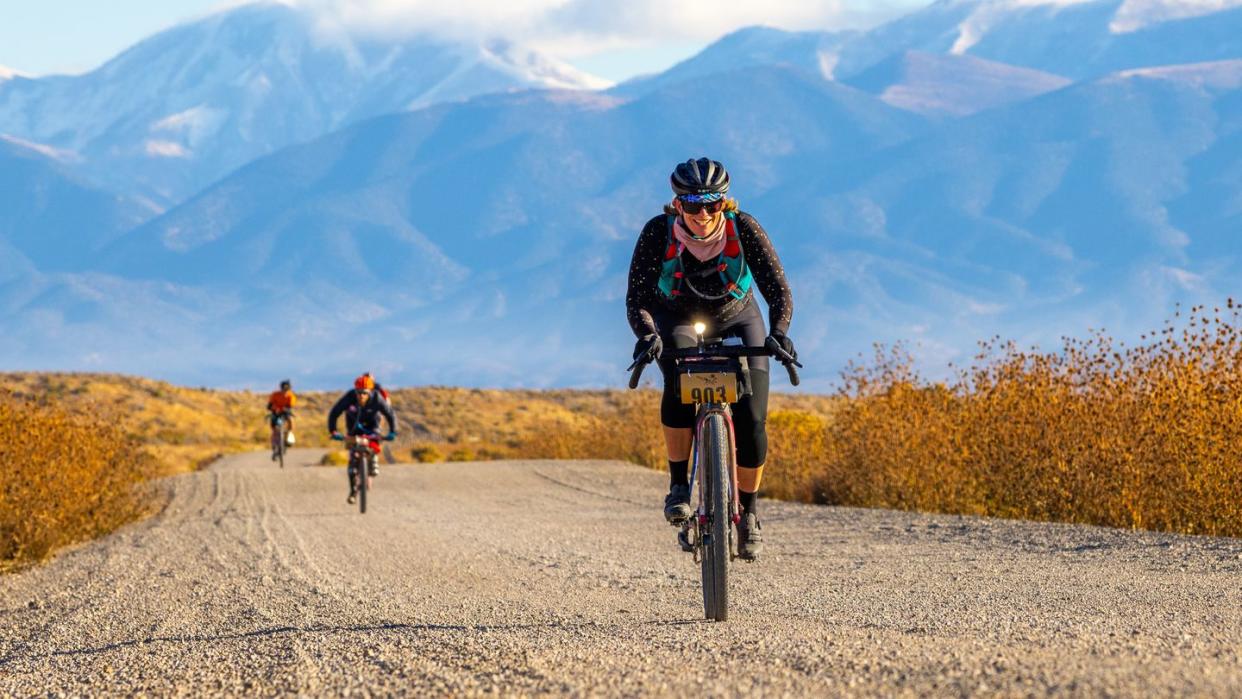
On a chilly November morning in 2019, 14 cyclists lined up to load their bikes onto a commuter train in Salt Lake City. The destination was Lehi, Utah, and the ragtag group’s goal was to ride the newly named Stupid Pony, a 200-mile historic mail route through the the West Desert, in one push. The ride, now hosted annually by a grassroots race organization called Salty & Stupid Cycling, begins in the sprawling suburbs of the Wasatch Front and travels to the Nevada border. The route would take the group through the remote sagebrush steppe ecosystem, where mountain ranges jut up against glistening salt flats and pronghorn herds bound across rabbitbrush-dotted basins. For many in the group, it would be their first ride in the area.
Join Bicycling for unlimited access to best-in-class storytelling, exhaustive gear reviews, and expert training advice that will make you a better cyclist.
Bobby Kennedy, one of the founders of Salty & Stupid Cycling, had gotten to know the West Desert during a troubling period in his life; it was the one place where he could spend a day completely alone. For most of his life, he has struggled with depression, the foe that “rises to smite every Kennedy,” he says. He’s had it for so long that he can barely remember his middle school years, which he describes as “just trying to hold together with duct tape.” And in the fall of 2019, Kennedy had reached another low point. He was not only battling imposter syndrome as an academic in his environmental humanities graduate program, but also working two jobs and trading childcare duties with his wife, Tasha, who worked full time herself. His son, Oran, had just turned 2 and wasn’t sleeping through the night, so neither were he and Tasha. “When you have every moment of your day booked, your world kind of keeps shrinking and shrinking,” he says.
When he could manage to take the day away, Kennedy would ride his bike in the West Desert, less than an hour from town. Pedaling those endless dirt roads, he would “grind and grind and grind until everything hurt so bad that it cancels out,” he says. “If you get one valley over from the nearest settlement, you can very realistically pretend that your problems are very far away.”
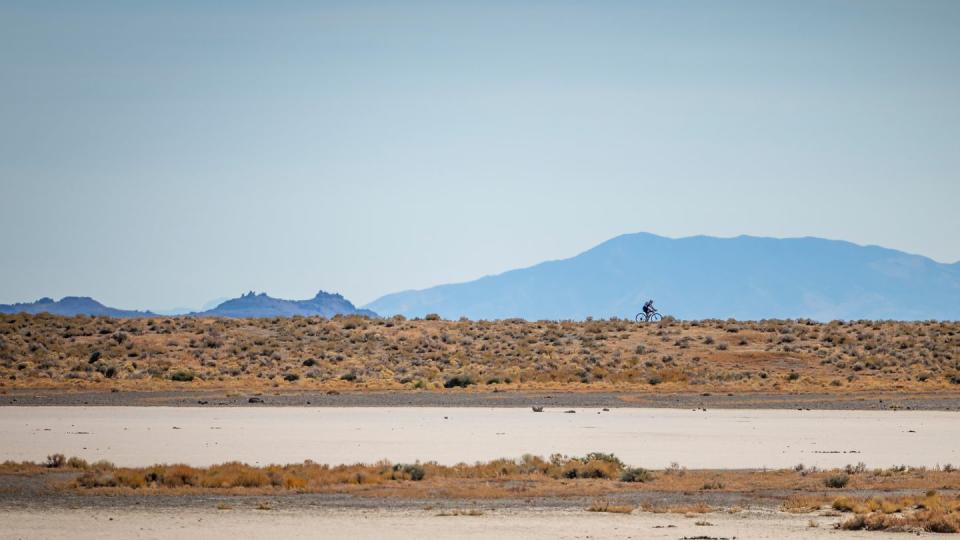
Kennedy could find solitude there because despite its proximity to Salt Lake City, the West Desert has never been a hotspot for human-powered recreation. The rugged, wide-open roads and long distances lend themselves more to dirt bikes and ATVs than hikers and mountain bikers. But if you head west out of the city, you must drive straight through it. “No one ever really talks about it,” says Jamie Sabuda, a local cyclist. “Most people just have blinders on the whole time.” Wayne Butler grew up within an hour’s drive from the West Desert, but before he got into cycling, he didn’t know much about the area. “You go out there and take your four-wheelers and shoot guns—that was my perception,” he says. “I thought there was nothing out there but dirt and stuff to shoot at, which isn’t even close to reality.” He had no idea that there were big mountain ranges and extensive road systems perfect for adventure riding.
When viewed from afar, the West Desert is what most people would describe as desolate. “It may look like there’s not much out there, but that’s part of the beauty,” Kennedy says. “Everything is just hiding in plain sight. You can ride these incredibly varied roads that go up and down into gullies, out of washes, over a rocky outcropping with multicolored stone.” The vastness of the landscape plays with your eyes and messes with your sense of scale. “I imagine if you could stand at the bottom of the ocean and look up and see everything around you, that’s how you’d feel,” he says.
But the area has a dark past: It is home to the nearly 800,000-acre Dugway Proving Ground, a U.S. Army facility established in 1942 to test chemical and biological weapons. Decades of top-secret testing has tainted residents’ perspectives of the region.
One of the most significant testing events at Dugway occurred in 1968 when an F-4 Phantom fighter jet flew above the military base spraying 320 gallons of VX, a deadly nerve agent, out of pressurized tanks. (A 1994 news report noted that a pinhead-size drop of VX on a person’s skin could be lethal.) Toxic droplets of liquid were swept up by the wind and sprinkled over vegetation as far as 45 miles away. Over the next few days, some 6,000 sheep that had been grazing the land in Skull Valley started acting “crazy in the head,” according to a local herder in a 1968 issue of Science. Some of the sheep couldn’t hold their heads up, while others couldn’t get up after falling over—a sign of central nervous system damage. More than 4,000 dropped dead. At first the Army denied any involvement. Although the government didn’t release a public report until more than 20 years later, the National Communicable Disease Center found trace amounts of VX in the affected sheep.
In 1969, in response to the incident, President Nixon banned all biological and open-air chemical testing, but the episode was notorious enough to instill fear of the West Desert in people around the country. Now that memory is less fresh, the region has been coming back to life in recent years, and a slew of gravel races is rejuvenating the region by introducing cyclists to this overlooked environment.
Kennedy is from Iowa, but he learned about the West Desert from one of his graduate program professors, Gregory Smoak (a cross between “Indiana Jones and public historian,” he says). Smoak had invited his students to drive the old Pony Express National Historic Trail, an overland mail route that served small mining towns during the Gold Rush. Rattling down the road in a Toyota FJ Cruiser, Kennedy and his cohort listened to historians tell tales of the boom-and-bust era and military escapades. He had never experienced anything like it. “The mountains were completely alien to me,” he says. “The sands, the juniper, the super low pinyon—it was the most beautiful thing I’d ever seen.”
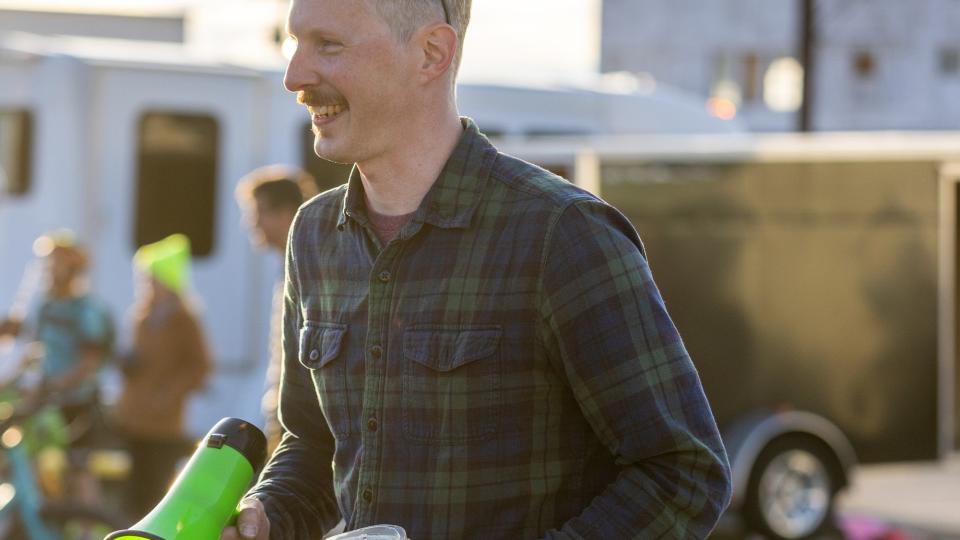
After that trip, Kennedy returned a few times to ride and bikepack, but it wasn’t until the fall of 2019, when his world was caving in, that he dreamed up an idea: He wanted to cycle the 200-mile Pony Express National Historic Trail to Wendover, Nevada, in a single push. “I knew I couldn’t leave Tasha with Oran for long, but I wanted that feeling of really being out there and untethered,” he says. So one day he posted a message on the Utah Gravel Grinders Facebook group to see if anyone was interested in joining him.
Two months and a lot of planning later, 14 people showed up. Kennedy equipped his green Surly Ogre with a full bikepacking setup; Jackie Baker, a local cyclist and the director of the Utah Mixed Epic, loaded her steel frame Breadwinner G-Road with her entire bivvy kit. Jamie Sabuda had a beaten-down aluminum Niner bike and a few snacks stuffed in a running vest. He didn’t even bring a helmet. One rider, Bjorn Nicolaisen, brought so much food that he had six pounds left over when he reached Wendover. Some riders, like Nathan Manwaring and Jeff Sumsion, were kitted out and ready to race (and eventually clocked in under 15 hours), while others just wanted to see if it was possible.
After a bit of confusion (and, as Sabuda remembers, disorganization), Kennedy yelled “Go!” and the group was off, with three riders—Manwaring, Sabuda, and Sumsion—jetting so far ahead that they didn’t see the others the entire ride.
It’s not that people didn’t ride in the West Desert prior to 2019; they did, but there weren’t many of them. Chris Magerl, a former pro cycling coach, started riding in the area after seeing it on his highway commute. “In the first few years, I never saw another bike or bike track,” Magerl says. So in 2015 he established a race called the Wild Horse, a 76-mile course in the West Desert’s Cedar Mountains and now one of the longest-running gravel races in Utah.
Then in 2020, Kennedy paired up with Wendover locals John Hernandez and Becky Spillman Benson to create Salty & Stupid Cycling, turning the Stupid Pony into an official race and pairing it with the Salty Lizard 100, a 106-mile Wendover course that Hernandez created. “While rides all over the West were gobbled up by Life Time and the Belgian Waffle Ride, we were able to find gold where they didn’t care to look,” Kennedy says. And their races are a bit more personable than the other “buttoned-up races,” as Kennedy calls them. He takes some creative liberties with the advertising and writes his social media posts as if he’s explaining the rides to a friend, not afraid of some porta-potty humor. Part of this charm also comes from the transparent number of locals who help out. Spillman Benson isn’t a cyclist, but she is the brains behind all the logistics duties—getting permits, wrangling volunteers, and more. “I’m in charge of all the boring stuff,” she says. “My dad grew up in Wendover, so I have a lot of family out there and they help run the aid stations.”
One of the aid stations is in the historic mining town of Gold Hill, where each year Karen Shepherd, Hernandez’s niece, sets up with her husband in a cozy cabin equipped with a bar, a bunkhouse, and a fireplace (mighty tempting for tired riders). “It is [very] much your Old West saloon,” Shepherd says. “Any kind of wood you can find was slapped up for the walls, roof, and floor.”
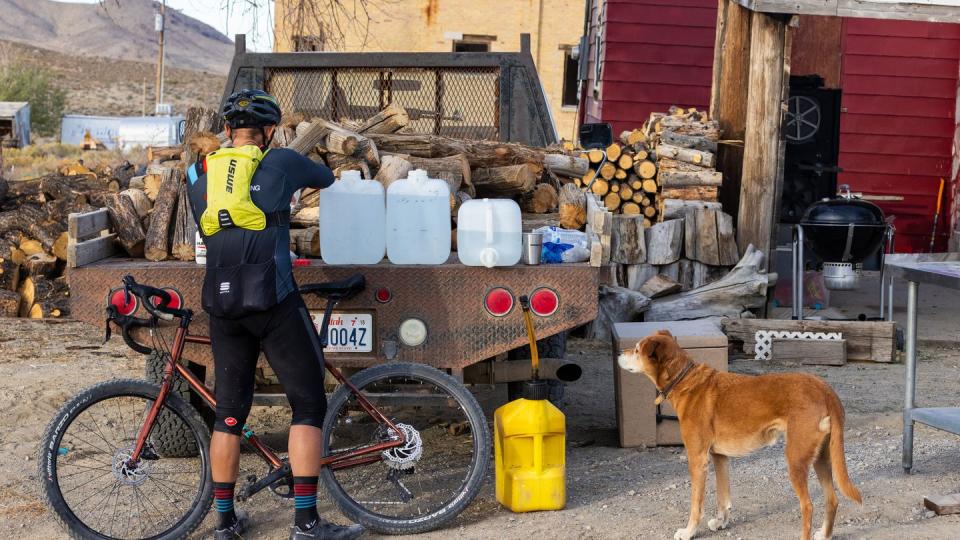
During the first Stupid Pony, Shepherd remembers temperatures dropping into the single digits: “My husband kept saying ‘Karen, do they know what they’re getting themselves into? It’s dangerous!’ I just said, ‘Well, all the more reason we should be there.’” And so they went. As riders stumbled in, the couple and their friends would greet them with chili and other warm food. Shepherd would whip up grilled cheeses on a propane grill and always had a bottle of whiskey handy: “Some of [the riders] are ready to party and have fun, and some of them are tapping out and asking ‘when is the pickup wagon coming?’ so we just wrap them in a blanket and set them by the fire and cater to what they might need.”
For Kennedy and others who were hesitant to attempt a 200-mile unsupported ride in the harsh desert environment, the Stupid Pony was an opportunity to get a taste of ultra endeavors. “One of the things that drew me to it,” Baker says, “was that I could try a longer route that might be doable in a day, but maybe not.” Sabuda says that after that race, he got much more serious about cycling.
And during the pandemic, people’s attitudes toward the West Desert started changing. “Suddenly, being in a place where there would be no other humans for a day’s journey wasn’t such a bad thing,” says Kennedy. “If claustrophobia is the effect of COVID-19, then those huge scenes where you can see anybody coming from miles away are appealing.” In the past few years, Jackie Baker has started to see more cyclists in the West Desert during her training rides, perhaps because of the growth of gravel riding, but also because of the area’s proximity to Salt Lake. “The race loops are really accessible to find right off the freeway,” she says.
Despite the increased interest, Magerl had to cancel the Wild Horse two years in a row at the last minute because of restrictions related to COVID-19. Before the event days in 2020 and 2021, he had already doled out thousands of dollars for permits, insurance, prizes, and porta-potties. “Financially, it was crippling,” he says. “The risk-to-reward ratio was not right for me anymore.” He had heard about the races Kennedy, Spillman Benson, and Hernandez were hosting in the West Desert, and he appreciated the spirit of their events. “It matched the low-key vibe of the Wild Horse.” So, with Kennedy’s blessing, Salty & Stupid took the reins.
This year, the Wild Horse sold out its 300-person allowance. (In 2022, 235 racers signed up.) The Stupid Pony and Salty Lizard 100 races take place over one weekend, usually in October. For the past few years, Salty & Stupid have hosted these three events.
The harsh landscape and remote nature of the Stupid Pony’s route pose unique challenges to the race directors. Magerl learned this the hard way one year when he was flagging the Wild Horse route. “Everything you put up that’s vertical, the cattle will use as a scratching post,” he says. So instead of stakes, he decided to use pin flags. He stuck them in the ground and started walking back to his truck. When he turned around, a cow was munching on his course markers. “They will eat anything,” he says, laughing. And they do: The open-range cattle and sheep feast on native grasses, leaving bare dirt and creating inhospitable conditions for pronghorn and other native species. The image of the area is tarnished, too, as vast tracts of vegetation-starved earth add to the sense of desolation.
The West Desert weather is equally challenging. Summers are brutally hot, but winters bring a chance of snow. And if the conditions aren’t prime, if there’s any moisture in the earth, the bentonite clay will clump up on tires and lodge in the frame until your wheels can’t spin anymore. It’s not just inconvenient; it’s hazardous if you’re halfway through a 100-mile loop. “If it starts raining, the mud will make it impossible for you to walk and even push your bike. You’ll be lucky to get yourself out, and you’ll definitely abandon your bike,” Magerl says. For a race director, this possibility is nerve-racking. This year, Salty & Stupid wound up canceling the Wild Horse because of the risk of muddy conditions.
It was well past dark as riders left the Gold Hill aid station on that first ride in 2019, and they still had over 50 miles to go until Wendover. By this point, the riders were all feeling wrecked. Kennedy, who’d underestimated the mileage, said it was all downhill from Gold Hill. In reality, though, they faced one of the biggest climbs yet. (The course has since been rerouted.) Temperatures plummeted, and Sabuda, who’d only brought a light jacket, couldn’t contain his shivering.
Kennedy rolled to the finish line in the Wendover Historic Airfield Museum nearly 20 hours after he started. “I literally crawled through the museum entrance on the tile of this beautiful parquet floor,” he recalls. “I had to sit on the ground because I couldn’t support myself upright.” But even though he was on the brink of hallucination, Kennedy felt better than he had in a long time. “It would be hard to overstate how much confidence you get from doing something almost nobody’s done before,” he says. “God,” he paused and let out a big sigh. “Nobody had ever done it; I couldn’t find a single instance of somebody crossing that whole stretch in a day [on a bike.]”
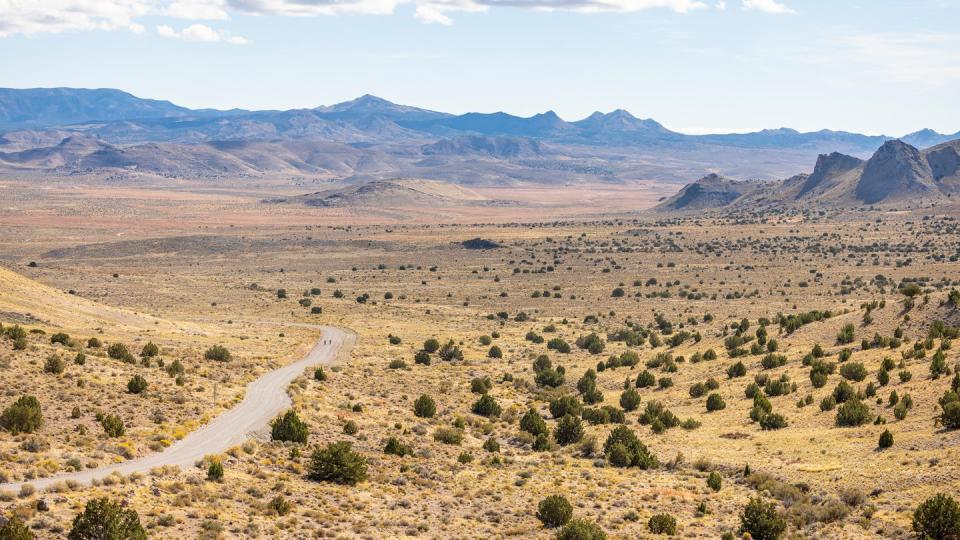
The handful of cyclists who finished the course set up camp in the large main room of the museum. Sabuda and others threw their sleeping bags down underneath a glass case with a life-size replica of the Little Boy, the atomic bomb dropped on Hiroshima by the Enola Gay on August 6, 1945. It was there in the West Desert that the Enola Gay crew trained and the B-29 bomber was housed. As the cyclists slept, military history loomed above their heads.
The next morning, everyone met at the Salt Flats Cafe in Wendover for breakfast, buzzing with excitement and sharing their stories. “I’m so used to…” Kennedy hesitated. “In academia, you don’t get much positive feedback.” But as he sat there with his fellow cyclists, the excitement was contagious. “There’s this kind of lovely echo when you’re excited, so they get excited, so you get more excited that they’re excited,” Kennedy says, laughing. Their response to his event boosted his confidence, and after the event Kennedy went from having a small social circle to a full-on community.
“It was cool to be at the center of this thing that people wanted to do, and to bring people along and try to show them that this thing was worthwhile and beautiful,” Kennedy says.
This year, on what was likely the last edition of the Stupid Pony, Kennedy arrived at the start line in the early morning with plenty of time to take it all in. Earlier this year, he and his family relocated to Iowa, so in 2024, Dave Harward and Breanne Nalder-Harward, who run the Dirty Dino Gravel Grinder in Vernal, Utah, are taking over the series. They will continue the Wild Horse and Salty Lizard 100, but at the time of this writing, the Stupid Pony has an uncertain future.
That morning in October, the temperature was a chilly 25 degrees Fahrenheit, and “the rabbitbrush was in fine form,” says Kennedy. “I couldn’t get enough of that morning… It was so damned quiet; the OHVers hadn’t arrived yet. And I watched the sun rising range by range.” A little later, he would send 30 or so very good friends and strangers off on their own West Desert adventure one last time.
About four hours into the race, riders and volunteers paused on the course to unfold their paper and polymer glasses and watch the annular eclipse taking place that morning. With their necks crunched, they watched the moon crossing in front of the midmorning sun as the colors of dusk lightly covered the desert sky—just as if they were standing at the bottom of the ocean taking it all in. “That was wonderful… I can’t believe how lucky we were to get to ride that day,” says Kennedy.
You Might Also Like

